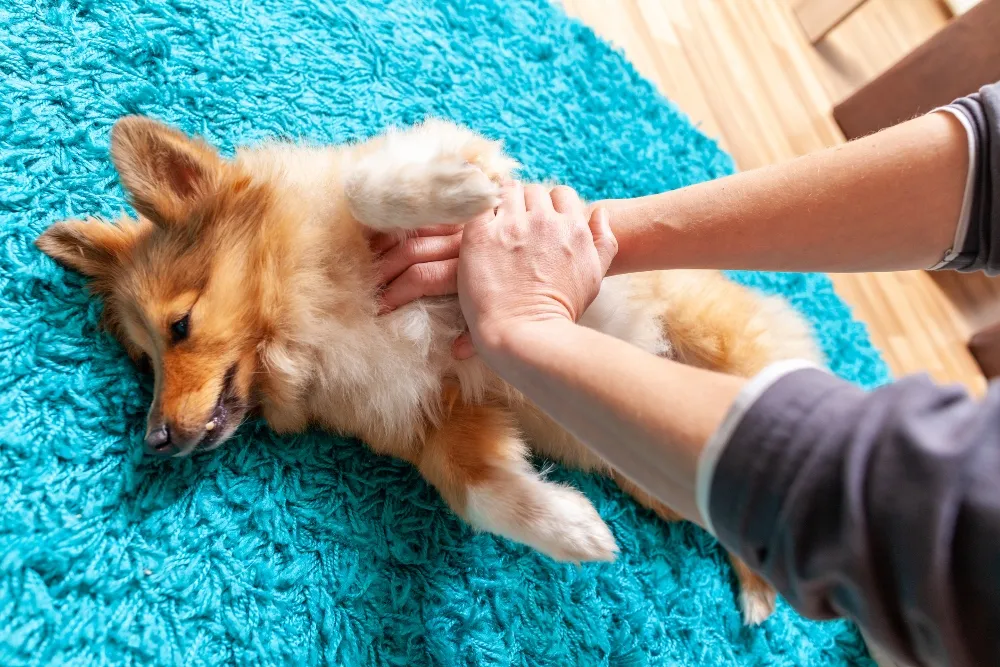Table of Contents
You probably (hopefully!) will never need to administer cardiopulmonary resuscitation, or CPR, to your dog. However, it’s important to understand what is involved in dog CPR, just in case. While CPR in dogs is very similar to CPR in humans, there are some key differences that you should be familiar with before potentially finding yourself in this position.
How to Administer CPR on a Dog: Step-by-Step Instructions
- Make sure the dog’s airway is clear. Look in your dog’s mouth to see if there are any objects, fluids, or other materials obstructing the airway. If there is a large ball or other object visible in your dog’s mouth or throat, attempt to remove it carefully. Use caution to avoid pushing the object further into your dog’s airway.
- Determine whether the dog is breathing. With your dog lying on their side, watch carefully and look for rising and falling of your dog’s chest. If your dog is breathing, there is no need to perform CPR. If your dog is not breathing, proceed to the next step.
- Check for a heartbeat. Place your hand gently on your dog’s chest to feel for a heartbeat. In a small or medium-sized dog, you should be able to lay your hand across or around your dog’s entire chest and feel the heart. In the case of a large-breed dog, it can be difficult to feel the heartbeat, and you’ll want to make sure you are feeling the correct location. Flex your dog’s leg at the elbow and shoulder, looking for the area where the bend of the elbow lays over the chest. You should be able to feel your dog’s heartbeat in this approximate area.
- Position your dog for chest compressions. Like in human CPR, you will need to give your dog chest compressions. However, the position of your hands will depend upon your dog’s conformation. In the case of very small dogs and puppies, wrap your hand around the dog’s chest and squeeze the entire ribcage. For medium and large-breed deep-chested dogs, lay your dog on their side and position your hands over your dog’s heart, overlapping them. (Again, use the bend of your dog’s elbow to locate the heart.) If you have a large barrel-chested dog, such as an English Bulldog, laying your dog on its back will allow the best access for chest compressions.
- Begin giving chest compressions. When giving chest compressions, your goal is to compress the chest by one-third to one-half. Wait for the chest wall to completely come back up before giving the next chest compression. Give chest compressions rate of 100-120 beats per minute; singing or humming the Bee Gee’s song “Stayin’ Alive” will help you achieve an appropriate heart rate. Perform a total of 30 chest compressions, then move on to the next step.
- Place your mouth over your dog’s airway. Gently close your dog’s mouth and extend their neck. Cover both of your pet’s nostrils with your mouth, ensuring an airtight seal.
- Perform artificial respirations. While watching to ensure that your dog’s chest rises with each breath, give your dog two slow rescue breaths.
- Assess your dog. Pause for a second, watching your dog to see if their breathing or heartbeat returns. If your dog begins breathing and/or develops a heartbeat, monitor your dog closely while heading to the nearest veterinary hospital.
- Repeat if applicable. If your dog is still not breathing and the heart is not beating, repeat cycles of 30 chest compressions and two rescue breaths. Pause briefly to assess your dog’s breath between cycles.
- Seek veterinary care. Whether or not your dog’s breathing and heartbeat return, your dog needs immediate veterinary care. If possible, you should be performing CPR while on your way to the nearest available veterinary hospital. Even if your CPR efforts succeed and your dog’s breathing and heartbeat return, your dog will still require veterinary care for their underlying injuries or illness.
When is CPR necessary?
Cardiopulmonary resuscitation should only be performed on dogs that are not breathing and do not have a heartbeat.
If your dog loses consciousness but is still breathing or still has a heartbeat, there is no reason to waste time initiating CPR. Instead, take your dog to a veterinary emergency hospital immediately. Performing CPR unnecessarily can cause injury to your dog, in addition to delaying needed care. Aggressive chest compressions may result in cracked ribs, so we never want to perform CPR unless it is essential to your dog’s survival.
There are many potential scenarios in which a dog might need CPR. These scenarios include, but are not limited to: choking, drowning, blood loss (after being hit by a car or involved in a severe dogfight), and severe illness.
What is the prognosis for dogs receiving CPR?
If your dog needs CPR, they are seriously ill or have sustained a serious injury. Therefore, your dog’s prognosis is guarded, even with the best possible care.
Providing CPR is never a replacement for emergency veterinary care. Instead, CPR is should be administered while on your way to the veterinary hospital, where your dog can receive the life-saving care that they truly need.
Summary
While we all hope that our dogs will never be in a position to require CPR, it’s best to be prepared. If your dog stops breathing and does not have a detectable heartbeat, a combination of chest compressions and rescue breaths provided during transport to an emergency veterinary hospital can improve your dog’s likelihood of a successful outcome.








